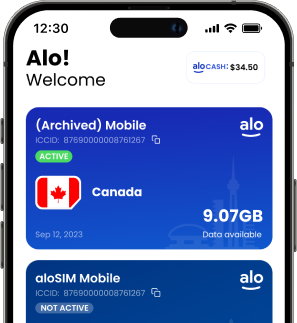Roaming charges are the fees you pay when you use your mobile phone outside of your normal coverage area, and they can add up quickly if you’re not careful.
What are roaming charges?
When you sign up for a data plan with a provider, you’re agreeing to pay a certain amount of money per month in exchange for a certain amount of mobile data in the area. But this data only “counts” if you remain within their coverage area — and the size of that area depends on your individual plan.
* Some mobile plans are limited to “local coverage,” so you’ll pay if you leave your local coverage area
* Other mobile plans include “nationwide coverage,” so you can use data all across your own country
Once you leave your coverage area, you’re no longer able to use the local data within your home network. Instead, your device needs to “roam” and latch onto the nearest available network. Because this isn’t your home network, you’ll pay a premium to use it.
Who has to pay roaming charges?
Anyone who travels outside of their cell phone plan’s regular coverage zone, without having a game plan for using their phone internationally. Sometimes this happens to people on vacation (especially if they’re not used to leaving the country), or Snowbirds heading south for the winter (especially if they’re not familiar with their phone settings).
When do roaming charges kick in?
* Making or receiving a call? Expect roaming charges in the form of active calling minutes.
* Sending or receiving text (SMS) message? Yup, more charges for each individual text.
* Browsing the internet? You’ll be charged per MB of data, and it adds up quickly.
* Sharing a photo on social media? Yet again, more roaming charges.
* Streaming music or video? Streaming can use a lot of data, so be careful!
* Checking in on social media? Roaming, roaming everywhere.
But even if you don’t do any of the above while you’re outside of your coverage area, you can still rack up roaming charges simply by keeping your device powered on.
That’s because mobile apps can be secretly working away in the background, checking for updates, doing backups, or monitoring your location … and they need data for that unless you’ve set them to only do this over Wi-Fi. (The default setting is to use data, and these apps don’t care if it’s local data or roaming data.)
How much are roaming charges?
The amount you’ll pay for roaming charges depends on your mobile carrier. Some carriers will send you a reminder text as soon as they realize you’ve left your local coverage area, reminding you that you’re no longer “at home” and additional charges may apply if you use your device.
Other carriers won’t warn you at all, which is unfortunate because sometimes people simply don’t understand roaming data and use their devices anyway (and are caught off guard when they see steep roaming charges on their next bill). The best roaming charges are non-existent roaming charges, so it’s best not to find out for yourself how much they’ll cost.

How can I avoid roaming charges?
You can avoid roaming charges by doing one of the following, while you’re leaving your home coverage area:
OPTION 1: Power off your device
We didn’t say this was a good option, but it’s certainly an option (if you don’t mind being unplugged for a while). If your phone is powered off, it can’t request to send or receive data, and you won’t be charged a penny.
OPTION 2: Turn off data roaming or use “Airplane Mode”
Turning off data roaming means you’re restricting your device from using any data (since you’re too far from home to use your home coverage data). You can, however, use Wi-Fi networks without worrying about a roaming charge.
- How to turn off data roaming on iPhones: Settings / Cellular / Switch Data Roaming to “OFF”
- How to turn off data roaming on Android phones: Apps / Settings / Mobile networks / Slide Data Roaming to “OFF”
- How to turn off data roaming on Windows phones: App List / Settings / Data roaming options / Select “Don’t roam”
Now, remember that even with Data Roaming toggled off, your carrier might charge roaming fees if you’ve previously used a carrier travel plan. (You know, one of those $15/day packages where you can travel internationally and pay a flat daily rate for data, calling, and texting.) So be sure you aren’t enrolled in one of these programs if you don’t want to be charged each day of your vacation.
Another option is to restrict your phone from any two-way communication and put it on Airplane Mode. This means no roaming data and no Wi-Fi, so your phone essentially becomes useful for playing (offline) games, listening to (offline) music, and … hmm, well, there’s always the calculator app?
- How to put your iPhone on Airplane Mode: Settings / Slide Airplane Mode to “ON”
- How to put your Android phone on Airplane Mode: Apps / Settings / Flight mode / Slide to “ON”
- How to put your Windows phone on Airplane Mode: App List / Settings / System / Airplane Mode / Slide to “ON”
OPTION 3: Ask your mobile carrier about a travel package
Carriers will often have set rates for travel packages, like a set dollar amount per day, so their customers can avoid wild, uncontrolled roaming charges. But be sure to review the package carefully, as you might end up paying three or four times what you’d normally pay in the run of a month. The fees vary depending on your carrier and your location, and some countries (ahem, Canadians) pay very high rates to use their phone abroad.
OPTION 4: Buy a local SIM card at your destination
This is often the most confusing option, but some travelers prefer to purchase a physical SIM card at their destination and swap it with the SIM card in their device. This gives them a local phone number and local data, but your device must be compatible with the network — and you’ll need to be careful not to lose your primary SIM card.
OPTION 5: Use a prepaid eSIM data package
An eSIM (embedded SIM) can give your phone affordable local data without messing with your device itself. Here at aloSIM, we make it easy to purchase, install, and activate an eSIM right on your device.
This means you’ll avoid roaming charges because you won’t need to use your home network. You’ll be fully connected on a local network, and you can watch your data usage. If you run out and want more, it’s easy to top up your eSIM, but there will never be any surprise charges.

Looking for more ways to avoid roaming charges? We’re listing five more options in our other article on how to to avoid roaming charges. But when it comes down to it, we always recommend using a prepaid eSIM data package. (Admittedly, we’re a little biased.)
Roam freely with an eSIM
An eSIM is a digital, downloadable SIM card. (You know that tiny plastic chip inside your phone? Imagine that, except … invisible!) Instead of adding and removing physical SIM cards, imagine if you could instantly download SIM cards for countries and regions all over the world. Well, now you can!
For example, let’s say you live in Canada but you’re going to skip across the pond and spend two weeks in London, England. If you don’t prepare your phone for an international trip, you will see roaming charges on your next cell phone bill because your Canadian carrier was stretching allllll the way across the Atlantic to make sure you connected to a local network in England.
But if you told your Canadian SIM card ‘Hey, don’t roam while I’m on vacation,’ and instead downloaded a U.K. eSIM card with a prepaid U.K. mobile data package, you would connect to those same local networks in England … for a fraction of the cost. That’s the magic of eSIM!
How does an eSIM prevent roaming charges?
Because an eSIM is local to a specific country or region, it makes *you* a local. So if you’re visiting Mexico and your phone has a Mexico eSIM installed, your phone is going to connect to those same Mexico towers as the local residents around you.
It’s similar to SIM card swapping, except it’s more efficient because you (A) don’t have to worry about losing or damaging your regular SIM card, (B) don’t have to mess with the insides of your phone, and (C) can continue to call and text on your regular phone number, if you want.
How to avoid roaming charges with an eSIM
1. Buy an eSIM for the country or region where you need data
2. Install your eSIM (digital SIM card) on any compatible device
3. Activate your data package when you’re ready to use it
No matter which option you choose, we encourage you to be mindful of roaming charges — and how to avoid them — so you don’t have to deal with an unexpectedly high phone bill.




